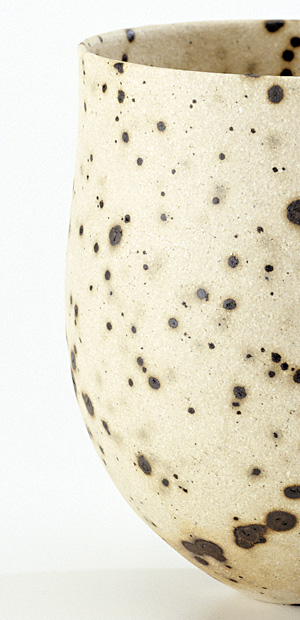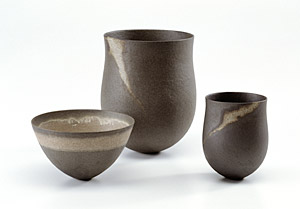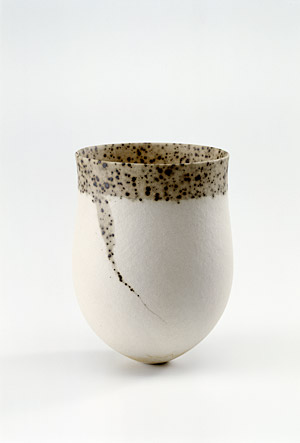Essays
of Form David Whiting
Jennifer Lee is a potter of silence. She does not issue artist’s statements and although naturally interested in ceramic debates she does not actively engage in them. She prefers simply to make – to focus on her work – pots which evolve slowly in the small studio at the rear of her house in London.
They are objects of exacting clarity, vessels which do not appear to have changed that radically over the years – until you compare what she makes today to those that were illustrated in books in the mid- eighties. Then you see the subtle and gradual developments; that while her palette has deepened and broadened, there is also an increased discipline and precision. Hers is an art that is built up and then honed down. Like stones on the beach that have matured geologically and then been smoothed by the elements, her pots appear to encompass a great deal about our world in concentrated form. They have no ‘message’ as such. You will find no politics or polemicism here. What her work does express is the continuing renewal of what the late Joanna Constantinidis called ‘latent energy’, not here of the wheel, but of a tension built up in the rising clay through the fingers, a kind of upward movement made through the symmetry and asymmetry of form and the stratified layers within. Yet, while these objects are suggestive of many things, they are also quietly and confidently self-contained.
Yet, while these objects are suggestive of many things, they are also quietly and confidently self-contained.Jennifer Lee’s creative certainty brought her success at a young age. Since leaving London’s Royal College of Art in 1983 she has gone on to exhibit all around the world and is represented now in over twenty-five public collections. She has had two museum retrospectives. Though long established in Camberwell, just south of the River Thames, her roots are very different. She was born into a farming family in Aberdeenshire, Scotland, a landscape to which she often returns. In the mid- seventies, after a brief flirtation with physiotherapy, she went to Edinburgh College of Art to study ceramics and tapestry. She then spent several months on a travelling scholarship in the United States, where she researched Southwest Indian prehistoric ceramics and visited West Coast potters, including Peter Voulkos, Paul Soldner and Ken Price. On returning to Britain she completed her ceramics studies at the Royal College of Art.
What is striking about the work is its constancy, the way in which she has been able to explore and fathom the constitution of clay and delineation of form through the endless possibilities of the cylinder and the bowl. Within these self-imposed parameters, her journey has in a sense moved inwards, gauging and re-gauging the interaction of profile and surface, interior and exterior, volume and lift. Right from the beginning there was a concern with poise and balance; the curvature of her pots swelling from a narrow base that creates a minimal point of contact with the surface on which they rest. It appears to make them float. But more than this, her pots often present, as Oliver Watson once observed, ‘an asymmetric disjuncture which disturbs their classical profiles.’
This is found not only in the sedimentary motion of the work, but in Lee’s approach to contour. Rims often lean or deviate in other ways. She has made ‘shelf rims’, which partially close the opening and naturally transform the nature and light of the contained space. Lips have been extended outwards and tilted. Some pieces have had softly emerging ridges - interventions that grow seamlessly from the main body. They clearly relate to some of the most elemental of early pots, from Bronze Age bowls to the stratified colouration of Ancient Egyptian wares found on numerous grave sites. Yet she also achieves a precision that distills and condenses what she has seen and experienced. They are pots which, singly or in related sculptural groups, have a very modern intelligence.
These carefully judged tonal variations create a symbiosis between inside and outside that avoids the dividing skin of a covering glaze.The superb vessels made in pre-dynastic Egypt, on the Upper Nile, certainly have affiliations with Lee’s work. These early pots, made from red Nile silt or hard buff marl clay, are among the most abstract we know. The Egyptologist Jaromír Málek said that they are remarkable for their ‘subdued elegance’, surely a description we could apply to Lee’s ceramics. She too builds up her shapes from coils or strips of rolled clay - but whereas the black crests that characterise those Egyptian pots were achieved through the firing process, Lee’s colour is introduced into the clay by mixing in metallic oxides. These carefully judged tonal variations create a symbiosis between inside and outside that avoids the dividing skin of a covering glaze. Moreover the horizontal and diagonal layers and veins of staining add to the sensation that these objects hover and shift in space. They have a posture and equilibrium that is far from static. Those Egyptian pots were burnished to create their glossy surfaces. Lee’s patient abrading and burnishing completes that sense of wind-polished geology, but to see them solely as evocations or excavations of landscape is rather limiting. One critic has recently related her art to colour field painting and her best work has a comparable geometry of hues. Reminiscent of Mark Rothko, there is a similar ambiguity of depth and space. While some pots are more arid, with coarser speckled stains, others have a more liquid and vaporous quality, like watercolour or a bank of rain cloud. In fact Lee is just as much a painter as she is a potter, but whose abstraction is expressed in the three-dimensional terms of enclosed form.
Looking back at the work Lee produced in the early eighties, after she left the Royal College, we realize what a different kind of potter she was in the milieu of that time. Her work did not exemplify the loud colour, glitz and baroque forms of so many of that generation. Instead her pots seemed, as they remain, disarmingly simple. They continue to allude to natural and man-made archetypes, to history and the passage of time. Their broad frame of reference removes them from any sense of the specific. Today the pots seem more economic in form, but increasingly complex and virtuoso in their distribution and densities of colour. Some pieces are best appreciated when placed with near relations - to fully understand how a formal idea is developed and carried through before she moves on. Lee’s art is not concerned with fashion or sudden stylistic changes of gear. It evolves on its own terms, regardless of the temperature in the outside world.
David Whiting
2003
Reproduced from Ceramics Monthly, October 2003, pages 38-41
with kind permission of the American Ceramic Society, www.ceramics.org. ©2003.

12.6 x 10.6 cm

28.6 x 14.1 cm.
Speckled coral, haloed bands 2003
8.7 x 16.1 cm

12.6 x 10.6 cm

11.2 x 19.3 cm
Dark olive, haloed granite trace 2002
24.7 x 19 cm
Dark, haloed granite trace 2003
15.6 x 11.5 cm

26.8 x 19.1 cm